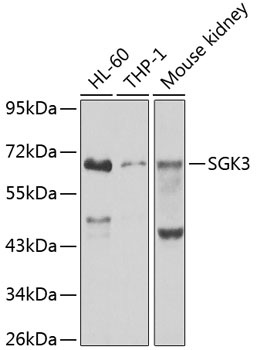
Immunohistochemistry of paraffin-embedded human cervical cancer using CSB-PA839296ESR2HU at dilution of 1:100
SGK3 Antibody
CSB-PA839296ESR2HU
ApplicationsELISA, ImmunoHistoChemistry
Product group Antibodies
ReactivityHuman
TargetSGK3
Overview
- SupplierCusabio
- Product NameSGK3 Antibody
- Delivery Days Customer20
- ApplicationsELISA, ImmunoHistoChemistry
- CertificationResearch Use Only
- ClonalityPolyclonal
- ConjugateUnconjugated
- Gene ID23678
- Target nameSGK3
- Target descriptionserum/glucocorticoid regulated kinase family member 3
- Target synonymsCISK, SGK2, SGKL, serine/threonine-protein kinase Sgk3, cytokine-independent survival kinase
- HostRabbit
- IsotypeIgG
- Protein IDQ96BR1
- Protein NameSerine/threonine-protein kinase Sgk3
- Scientific DescriptionSerine/threonine-protein kinase which is involved in the regulation of a wide variety of ion channels, membrane transporters, cell growth, proliferation, survival and migration. Up-regulates Na+ channels: SCNN1A/ENAC and SCN5A, K+ channels: KCNA3/KV1.3, KCNE1, KCNQ1 and KCNH2/HERG, epithelial Ca2+ channels: TRPV5 and TRPV6, chloride channel: BSND, creatine transporter: SLC6A8, Na+/dicarboxylate cotransporter: SLC13A2/NADC1, Na+-dependent phosphate cotransporter: SLC34A2/NAPI-2B, amino acid transporters: SLC1A5/ASCT2 and SLC6A19, glutamate transporters: SLC1A3/EAAT1, SLC1A6/EAAT4 and SLC1A7/EAAT5, glutamate receptors: GRIA1/GLUR1 and GRIK2/GLUR6, Na+/H+ exchanger: SLC9A3/NHE3, and the Na+/K+ ATPase. Plays a role in the regulation of renal tubular phosphate transport and bone density. Phosphorylates NEDD4L and GSK3B. Positively regulates ER transcription activity through phosphorylation of FLII. Negatively regulates the function of ITCH/AIP4 via its phosphorylation and thereby prevents CXCR4 from being efficiently sorted to lysosomes.
- ReactivityHuman
- Storage Instruction-20°C or -80°C
- UNSPSC41116161




